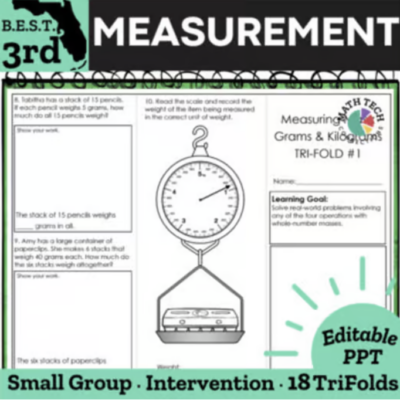Young children experience the measurable attribute of mass and weight as “heavy” or “light.” Learning how to measure in standard units in the 3rd grade (metric and customary) gives students more precise vocabulary to talk about mass and weight.
MA.3.M.1.2 – Solve real-world problems involving any of the four operations with whole-number mass and weight.

Measuring Mass & Weight in 3rd Grade
Like other measurable attributes, working with mass and weight is an opportunity for kids to read measurements on different tools. They can also practice grade level operations with measurement quantities to answer questions like “How much less?”
The Florida’s B.E.S.T. standard for measuring mass and weight doesn’t actually specify that 3rd graders will measure mass and weight. It only asks that they solve “real world problems.”
However, students will not be able to understand real-world problems without understanding real-world measurement!

What is the Difference Between Mass & Weight?!
Mass and weight are not exactly the same attribute, even though they are often used interchangeably in the United States. Weight is the amount of force exerted on an object by gravity, or how heavy it is. Since the Moon has far less gravity than Earth, things will weigh far less on the Moon than on Earth.

In the 3rd grade, students should understand and be able to work with ounces and pounds.
Mass, on the other hand, is the amount of matter in an object. Matter does not change based on gravity, so the mass of an object will be the same on the Moon and on Earth.
This is a specific distinction that may be abstract for 3rd graders! In 3rd grade, students should be able to work with grams and kilograms as measures of mass.
Weight
3rd graders need to develop internal benchmarks for basic units of measure. This allows them to understand other measurements related to their internal benchmarks.
These benchmarks are developed by experiencing and measuring weight with measuring tools like scales.For example, ounces are small like grams, but relatively heavier.
A relatable analogy is the difference between the mass of a small paperclip (1 gram) versus the weight of a piece of bread (1+ ounces).
A pound is a collection of 16 ounces. Pounds are used to measure heavier objects.

Mass

Mass is measured in metric units based on the gram. Grams are very light! A thumbtack has a mass of about 1 gram. Milligrams are 1 one-thousandth of a gram, but students won’t work with them until the 4th grade.
A collection of 1,000 grams is 1 kilogram. Kilograms measure the mass of everything from a loaf of bread to an elephant. Students should experience measuring mass and weight in different units and with different tools before trying to solve operations involving those units.
Standards
The Common Core Standards state that 3rd graders will be able to measure, estimate, AND solve problems involving mass. While this is simpler than working with mass and weight, it leaves out experience with the weight measurements we use in the United States.
The Texas Essential Knowledge Standards incorporate both metric and customary units but does call them both weight.
Florida’s B.E.S.T. Standards set the objective of having students solve real-world problems with mass and weight. As discussed in this post, 3rd graders need to experience measuring mass and weight to give measurements in real-world problems context.

The post Measuring Mass & Weight in 3rd Grade appeared first on Math Tech Connections.



